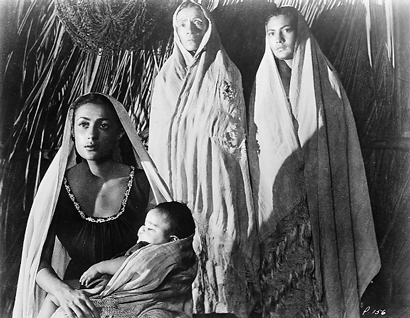Retrospective examines the melodramas of a nation’s apogee of cinematic output
In the Mexican film “Maria Candelaria,” the heroine, in the title role, is spited, humiliated, taunted and eventually stoned to death by her own people in part for being the daughter of a “tainted” woman. The portrayal of indigenous people is paternalistic and women fare the worst. So why is this melodrama studied, revered and watched over and over again?
Because it is one of the most important films from Mexico’s Golden Age of cinema.
“It is the only great cinematography in the world that hasn’t been seen by Americans,” said Fabiano Canosa, the organizer of Symphony Space’s “Mother Saints and Holy Whores” series, which opened on November 6 with “Maria Candelaria.”
The Golden Age of Mexican cinema is generally dated from 1935 through 1962, according to Nohemy Solorzano-Thompson, assistant professor of Spanish at Whitman College, and was a product of its times. During the Second World War, Hollywood turned its vision and dollars towards Mexico, creating some of the most influential films of its time. In fact, according to Alejandro Pelayo, Mexican consul for cultural affairs in Los Angeles, this period is considered the apogee of Mexican film because of their commercial success both in Mexico and abroad.
“The producers succeeded in getting a good exterior market,” he said. “During World War Two, less films were being produced from other countries and Mexico took advantage…and also in the interior with the growth of cities like Mexico City, Guadalajara and Monterrey.”
By the 40s, Mexico was producing between 20 and 40 movies per year (in contrast to between two and five now) and some of the world’s biggest stars including Maria Felix, Pedro Armendáriz, Dolores del Rio, Pedro Infante and Cantiflas, to name a few.
“It was a period of experimentation,” said Solorzano-Thompson, who wrote her doctoral thesis about this period of cinema. “A lot of new artists and directors come out of these films and became icons of their time.”
This experimentation is why, stylistically, the cinematic innovations of these films are just as important as their popularity and commercial success. According to Solorzano-Thompson, these films expanded the melodrama, presenting previously untouched themes facing a country at the cusp of modernity, and contributed to filmmaking techniques. In this way, they continue to influence and merit study.
“These films are still relevant because they address tensions that are still present in Mexican society,” Solorzano-Thompson said. “They still provoke emotions.”
Maria Candelaria is a perfect example. Directed by arguably the most important Mexican director of the period, Emilio “El Indio” Fernández, the film tells the story of an indigenous woman, who endures harassment and humiliation from the other townsfolk because her mother was a “fallen woman.” Maria, played by Dolores del Rio, is a simple flower seller who simply hopes to marry her sweetheart, Lorenzo Rafael (Pedro Almendáriz). Although the couple faces grave obstacles at every turn, the tide turns when a visiting artist is struck by her Indian beauty that he says embodies the purity of the Mexican race, and asks Maria to pose for a painting. When he superimposes her head on the body of another model, the villagers are outraged by the nude painting that results, and stone poor Maria to death. She dies tragically in the arms of her lover repeating, “I didn’t do anything wrong, Lorenzo Rafael, I didn’t do anything wrong.”
According to Solorzano-Thompson, Maria Candelaria is a clear demonstration of what she calls “the virgin-whore dichotomy” still present in Mexican society today.
“Films like ‘Maria Candelaria’ represent that impossible place for women in Mexican society,” Solorzano-Thompson said. “Women are expected to be pure—mothers and wives—but there is still a desire for easy women.”
At the same time, director Fernández is also exploring questions of urban versus rural lives, illuminating the Mexican saying, “Small town, big hell.” In his perspective, small towns, like Xochimilco where “Maria Candelaria” is set, are rural places full of ignorant, gossiping, puritanical Indians. But women, like Maria, and Mercedes, the protagonist of “Salón México,” another Fernández film which played the night of the festival, are caught between these two extremes—city life and pueblo life—that existed and persist in Mexico today.
“Maria Candelaria lives in this pre-modern existence, but is forced to face modernity,” Solorzano-Thompson said. Similarly, “‘Salón México’ is about another woman trying to make it in the city and caught in a moralistic dilemma.”
Fernández, whose mother was Kikapu Indian and was nicknamed “El Indio” for his pride in this heritage, nevertheless portrays indigenous people in a less then positive light. But while he chooses light-skinned actors for the leads, and presents Indians as evil and ignorant, for the time period, he was still a revolutionary filmmaker. He made Indians the center of his stories and convinced the world’s most sought-after actresses to play them.
Still, probably the most magnificent aspect of these films is the cinematography, which beautifully captures Mexico’s breathtaking scenery and people. For many of his films, Fernández used cameraman Gabriel Figuera, whose low camera angles, illusions of depth and ability to capture the splendor of black and white film, is now famously known as the “Fernández -Figueroa style.”
And for the organizer of the series, Canosa, who has loved these films from the moment he saw them as a youth in Rio de Janeiro, it is simply a pleasure to finally, after 35 years of trying, be able to share these movies—with subtitles—to an English speaking audience.
“It’s a feeling of exhilaration,” Canosa said. “Finally I have the place, the films, the artists to showcase this work… and this is just the tip of the iceberg. There is much more to come.”


































